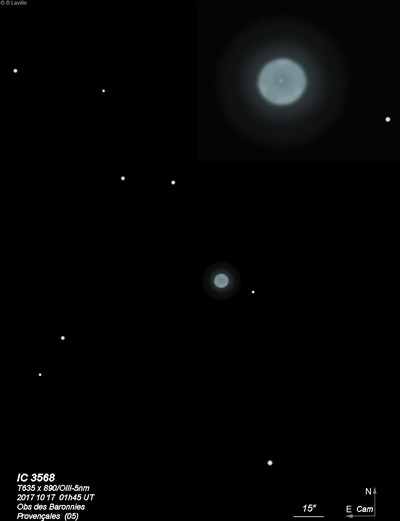
Robert G. Aitken discovered IC 3568 visually on 31 Aug 1900 while examining comet Borrelly-Brooks with the 12-inch refractor at Lick Observatory. The next night he examined it with the 36-inch and found a nebulous star or planetary with a mag 10.5-11 central star (BD +83°.357) within a 5"-6" halo. He noted it formed a 14.8" double (A 9001) with a mag 13 star. This object is Aiten's only discovery in the IC.
Based on Crossley photographs at Lick, Curtis (1918) reported "the nucleus is surrounded by very bright matter in a disk 18" in diameter, apparently perfectly round, and fading out a little at the edges."
In the 1956 book "Gaseous Nebulae", Lawrence Aller stated the "theoretician's planetary nebula" was most closely approximated by IC 3568. The 1987 study "The shapes and shaping of the planetary nebulae IC 3568, NGC 40, and NGC 6543" by Balick et al adds "If IC 3568 did not exist, it might have been created by theoreticians".
Brian Skiff notes the UGC misidentification (UGC 7731) as a galaxy. The UGC description is "Compact or *" and description "alm compl stellar on PA prints, prob extr compact gx." Because of the misclassification in UGC, this planetary is has the galaxy designation PGC 41662, though HyperLeda now shows the object type as a planetary.
200/250mm - 8" just non-stellar at 100x, definite disc seen at 165x. This planetary can take high power due to its high surface brightness.
300/350mm - 13.1" bright, small, round, high surface brightness disc 15" diameter. A mag 13.5 star is almost in contact at the west edge 15" from the center.
400/500mm - 17.5" (5/15/99): at 220x unfiltered, appears as a very small, high surface brightness disc, ~10" diameter with a mag 13.5-14 star close off the west edge. At 380x, the disc is concentrated to a quasi-stellar nucleus, but it was difficult to distinguish the central star due to the high surface brightness glow. Surrounding the central region is a much fainter, round, outer shell that increases the diameter to 15"-20". Seeing not steady enough for higher power.
900/1200mm - 48" (11/1/13): at 488x unfiltered contains an extremely high surface brightness inner disc, ~8" diameter. The mag 13.5 central star was only occasionally visible in very soft seeing. A fairly bright halo increases the diameter 2.5 times to roughly 20". A mag 13 star is just off the west side, ~15" from center (forms the double A 9001).
Notes by Steve Gottlieb